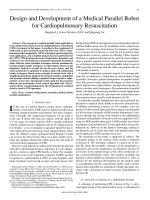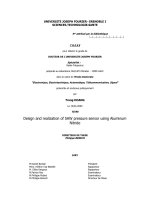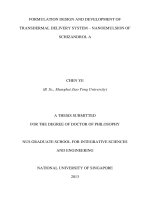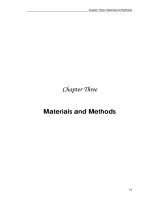Chapter 5 conclusions recommendations design and development of tissue engineering scafflods using rapid prototyping technology
Bạn đang xem bản rút gọn của tài liệu. Xem và tải ngay bản đầy đủ của tài liệu tại đây (45.05 KB, 6 trang )
Chapter Five: Conclusions and Recommendations
Chapter Five
Conclusions
and
Recommendations
197
Chapter Five: Conclusions and Recommendations
5.1 Conclusions
A desktop robot based rapid prototyping (DRBRP) melt extrusion system was
designed and developed in house in collaboration with other members in the
research team that allowed design and fabrication of 3D scaffolds for tissue
engineering applications. This technique directly extruded the material from its
granulated or any other form into 3D scaffold in contrast to traditional FDM
system that requires prefabricated filament pre-cursor. Most of the established
RP systems mainly focus on a single mode of material and/or scaffold
processing. The DRBRP was designed to give the user freedom to process a
large variety of polymers and/or scaffolds. Virtually, DRBRP system would
allow a wide range of thermoplastic material to process into 3D scaffold with
any lay-down pattern.
A range of synthetic biopolymers namely, PCL and PCL-based copolymers
(PCL-PEG, PCL-PEG-PCL and PEG-PCL-PLA) prepared by ring-opening
polymerization, were processed into 3D scaffolds with honeycomb-like
architecture, and fully interconnected and controllable pore channel. The
copolymer had the potential to modulate hydrophilicity and/or degradability
and consequently, the biomechanical properties of the matrices by varying the
ratio of the polymer components. The scaffold processing demonstrated in
one hand, the efficacy of the DRBRP technique to process a wide range of
biopolymers and on the other hand, the feasibility of these polymers to be
processed into 3D scaffolds.
198
Chapter Five: Conclusions and Recommendations
The morphological characterization (pore size, porosity and interconnectivity
measurement) by SEM, ultrapycnometer and micro-CT analyses revealed that
the lay-down pattern and filament distance were very effective means to
control the pore shape, size and porosity. The 0/90 lay-down pattern
produced quadrangular pores, 0/60 pattern resulted in triangular pores,
whereas 0/30 pattern formed complex polygonal pores. The pore height (in z-
direction) and porosity varied from 500 to 2500µm and 66 to 60%,
respectively due to the change of pattern from 0/90 to 0/30. Likewise, by
changing filament distance from 1.0 to 1.5 mm the pore width (in x- or y-
direction) and porosity varied from 500 to 1000µm and 50 to 66%,
respectively. Besides, the process parameters (liquefier temperature,
extrusion pressure and deposition speed) were found to have good control
over the deposited filament diameter and consequently, the pore size and
porosity. A range of filament diameter (375 to 623 µm) and porosity (45 to
75%) was obtained by varying the process parameters. In spite of significant
change in filament diameter, pore size and porosity, 100% pore
interconnectivity was maintained in all the scaffold structures.
Mechanical characterization revealed that different mechanical properties
could be achieved by utilizing different materials, while the design parameters
of the scaffold remained unchanged. The 0/90 lay-down pattern producing
66% porosity resulted in compressive stiffness, 1% offset yield strength and
yield strain of 34.87 MPa, 2.69 MPa and 3.5%, respectively for PCL scaffold,
and 29.8 MPa, 2.3 MPa and 2.98%, respectively for PCL-PEG scaffold.
Similar to porous characteristics, the lay-down pattern, filament distance and
199
Chapter Five: Conclusions and Recommendations
process parameters significantly influenced the mechanical properties that
were found to be porosity dependant. The loading direction, strain rate and
physiological environment also influenced the mechanical properties of the
scaffolds. The variation in strain rate revealed the viscoelastic property of the
scaffold, while the various loading direction investigated the anisotropy. The
compression test in PBS solution at 37˚C resulted in decrease of mechanical
properties. It might be due to the effect of external energy input and/or
plasticizing effect because of the presence of moisture. However, the
decrease was less significant than that was reported by other groups for
foam-like scaffolds made of copolymers of PGA/PLA.
In vitro degradation study demonstrated that both PCL and PCL-PEG
scaffolds realized homogeneous hydrolytic degradation via surface erosion
resulting in a consistent and predictable mass and material loss. The linear
mass loss caused uniform and linear increase in porosity that accorded with
the decrease in mechanical properties. The results indicated that the
incorporation of hydrophilic PEG into hydrophobic PCL enhanced the overall
hydrophilicity and degradability of the PCL-PEG copolymer. However, the
architectural variation did not influence the degradation kinetics. In reality,
accelerated degradation study does not provide conclusive information that
would occur in the actual physiological environment rather this procedure
enables the comparison of degradability among different scaffolds and
materials in a more acceptable time frame.
200
Chapter Five: Conclusions and Recommendations
The biocompatibility as well as the ability of the PCL and PCL-PEG scaffolds
to favour cell adhesion and function was evaluated successfully using rabbit
smooth muscle cells. Light, scanning electron, and confocal laser microscopy
showed cell adhesion, proliferation and extracellular matrix production on the
surface as well as inside the structure of both scaffold groups. The completely
interconnected and highly regular honeycomb-like pore morphology supported
bridging of the pores via cell-to-cell contact as well as production of
extracellular matrix. PCL-PEG copolymer scaffolds showed overall better
performance in cell culture studies than the PCL homopolymer scaffold that
was reflected by the DNA quantification assay. However, the variation in lay-
down pattern did not significantly influence the cell culture performance.
In summary, the results suggest that a scaffold family can be developed with
a range of morphological and biomechanical properties by various selections
of design and process parameters in combination with different polymers
using the in house built DRBRP technique.
201
Chapter Five: Conclusions and Recommendations
5.2 Recommendations
This PhD thesis was the part of a research program that aims to establish a
scaffold library that would have a database on the physical and biomechanical
characteristics of various scaffolds in relation to different materials and
designs. This data produced from this thesis would provide the tissue
engineer with guide line to develop scaffolds as required for the tissue
engineering applications. Accordingly, some of the areas that deserve further
research are listed below:
Physical and biomechanical characterization of the scaffolds that should
be fabricated using various nozzle sizes, mixed architectures in the same
structure and laying down multiple layers with same angle orientation.
Incorporation of bioactive agents, like hydroxyapatite (HA) or tri-calcium
phosphate (TCP) in the scaffold material to produce osteoconductive
scaffolds with adequate stiffness and strength for high load-bearing
applications.
Extensive qualitative and quantitative cell culture studies using human
cells.
In vivo study that investigates the degradation and resorption kinetics of
scaffold-tissue constructs in regard to foreign body reactions using
animal models.
Some predictive models (e.g. model for scaffold porosity based on
extruding materials and process parameters, model for degradation
kinetics and/or cell behavior) can be developed and applied to correlate
the compressive characteristics with the hatch pattern.
202









